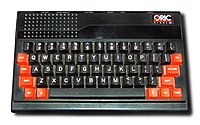This article has multiple issues. Please help improve it or discuss these issues on the talk page. (Learn how and when to remove these template messages)
|
 | |
| Developer | Tangerine Computer Systems[1] |
|---|---|
| Manufacturer | Tangerine Computer Systems |
| Type | Home computer |
| Generation | 8-bit |
| Release date | United Kingdom: 1 September 1982[1] |
| Discontinued | 1984 |
| Units sold | 210,000 in 1983 |
| Media | Cassette tape, Floppy disk |
| Operating system | Oric Extended Basic v1.0 |
| CPU | 6502A @ 1 MHz |
| Memory | 16 KB / 48 KB[2] |
| Display | 40×28 text characters; 240×200 pixels, 8 colours |
| Graphics | Custom ASIC (HSC 10017 ULA) |
| Sound | AY-3-8912 |
| Predecessor | Tangerine Microtan 65 |
| Successor | Oric Atmos |
 | |
| Developer | Tangerine Computer Systems |
|---|---|
| Manufacturer | Tangerine Computer Systems |
| Type | Home computer |
| Generation | 8-bit |
| Release date | United Kingdom: 1 February 1984[3] |
| Discontinued | 1985[4] |
| Media | Cassette tape, Floppy disk |
| Operating system | Oric Extended Basic V1.1 |
| CPU | 6502A @ 1 MHz |
| Memory | 16 KB / 48 KB[2] (16 KB more available with hardware hack[4]) |
| Predecessor | Oric-1 |
| Successor | Oric Stratos |
 | |
| Developer | Eureka Informatique |
|---|---|
| Manufacturer | Eureka Informatique |
| Type | Home computer |
| Generation | 8-bit |
| Release date | 1986 |
| Discontinued | 1988 |
| Units sold | 6,000 |
| Media | Cassette tape, Floppy disk |
| Operating system | HyperBasic |
| CPU | 6502A @ 1 MHz |
| Memory | 64 KB |
| Predecessor | Oric Atmos |
Oric was a brand of home computers sold in the 1980s by Tangerine Computer Systems. Tangerine was based in the United Kingdom and sold their computers primarily in Europe. All computers in the Oric line were based on the MOS Technology 6502A microprocessor.
With the success of the ZX Spectrum from Sinclair Research, Tangerine's backers suggested a home computer and Tangerine formed Oric Products International Ltd to develop the Oric-1. The computer was introduced in 1982.[5] During 1983, approximately 160,000 Oric-1 computers were sold in the UK, plus another 50,000 in France (where it was the year's top-selling machine). This resulted in Oric being acquired and given funding for a successor model, the 1984 Oric Atmos.
Oric was bought by Eureka, which produced the less successful Oric Telestrat (1986). Oric was dissolved the year the Telestrat was released. Eastern European legal clones of Oric machines were produced into the 1990s.
- ^ a b Haworth, Jonathan (1992). "Oric, the Story so far". oric.free.fr. Chapter 1: Conception and Birth. Retrieved 2017-06-23.
- ^ a b "OLD-COMPUTERS.COM : The Museum". www.old-computers.com. Retrieved 18 June 2017.
- ^ "OLD-COMPUTERS.COM : The Museum". www.old-computers.com. Retrieved 18 June 2017.
- ^ a b "Oric Atmos 48K". www.rigpix.com. Retrieved 18 June 2017.
- ^ Cite error: The named reference
register30was invoked but never defined (see the help page).
